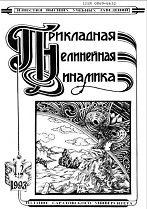|
This article is cited in 5 scientific papers (total in 5 papers)
APPLIED PROBLEMS OF NONLINEAR OSCILLATION AND WAVE THEORY
Link between the self-organization of dynamic cutting system and tool wear
V. L. Zakovorotnyj, V. E. Gvindzhilija
Don State Technical University, Rostov-on-Don
Abstract:
Purpose of this work is improvement the efficiency of the metal cutting process through the agreement of external control from the CNC system with internal dynamics of the system, its evolution manifested through development of tool wear and influenced on parameters and dynamic properties of interacting subsystems of the tool and workpiece. Methods. Mathematical model of the forces is provided to reveal the dynamic connection formed by the cutting process between subsystems of the tool and workpiece. Forces are presented in the coordinates of the state of the system using nonlinear functionally related integro-differential equations, the analysis of system is performed by numerical methods in the mathematical package Matlab, Simulink. Results. The article shows that the trajectory of the tool wear is fundamental changing during evolution of the system dynamic properties. Each unique trajectory is determined by the system initial parameters and sensitive to small parameters variations. In this result, many phenomena considered in the article are explained, including the existence of a limited range of cutting speed, at which the stability margin of the system is maximum, and the intensity of tool wear is minimal, which is confirmed by experiments of many researchers. Therefore, we propose ways to control wear on the basis of changing the parameters of dynamic system and controlled trajectories of the machine actuators. Conclusion. Wear rate depends on dynamic system parameters and their change, which depends on the phase trajectory of power of irreversible transformations of incoming energy on the perfect work. Therefore, in contrast to the known studies, the wear rate is considered not only depending on the parameters of the system and the formed attractive sets of deformation displacements, but also on the evolution of properties and parameters caused by irreversible energy transformations in the zone of cutting.
Keywords:
evolution of dynamic cutting system, wear rate, bifurcation of the attracting sets of deformantion displacement.
Received: 11.11.2019
Citation:
V. L. Zakovorotnyj, V. E. Gvindzhilija, “Link between the self-organization of dynamic cutting system and tool wear”, Izvestiya VUZ. Applied Nonlinear Dynamics, 28:1 (2020), 46–61
Linking options:
https://www.mathnet.ru/eng/ivp355 https://www.mathnet.ru/eng/ivp/v28/i1/p46
|

| Statistics & downloads: |
| Abstract page: | 140 | | Full-text PDF : | 39 |
|




 Contact us:
Contact us: Terms of Use
Terms of Use
 Registration to the website
Registration to the website Logotypes
Logotypes








 Citation in format
Citation in format 
